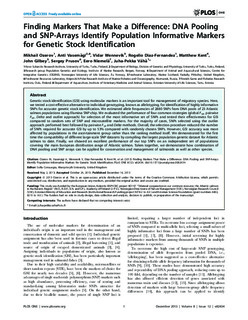| dc.contributor.author | Ozerov, Mikhail | |
| dc.contributor.author | Vasemägi, Anti | |
| dc.contributor.author | Wennevik, Vidar | |
| dc.contributor.author | Diaz-Fernandez, Rogelio | |
| dc.contributor.author | Kent, Matthew | |
| dc.contributor.author | Gilbey, John | |
| dc.contributor.author | Prusov, Sergey | |
| dc.contributor.author | Niemelä, Eero | |
| dc.contributor.author | Vähä, Juha-Pekka | |
| dc.date.accessioned | 2014-01-24T12:42:05Z | |
| dc.date.available | 2014-01-24T12:42:05Z | |
| dc.date.issued | 2013-12-16 | |
| dc.identifier.citation | Ozerov M, Vasema¨gi A, Wennevik V, Diaz-Fernandez R, Kent M, et al. (2013) Finding Markers That Make a Difference: DNA Pooling and SNP-Arrays Identify Population Informative Markers for Genetic Stock Identification. PLoS ONE 8(12): e82434. doi:10.1371/journal.pone.0082434 | no_NO |
| dc.identifier.issn | 1932-6203 | |
| dc.identifier.uri | http://hdl.handle.net/11250/109311 | |
| dc.description.abstract | Genetic stock identification (GSI) using molecular markers is an important tool for management of migratory species. Here, we tested a cost-effective alternative to individual genotyping, known as allelotyping, for identification of highly informative SNPs for accurate genetic stock identification. We estimated allele frequencies of 2880 SNPs from DNA pools of 23 Atlantic salmon populations using Illumina SNP-chip. We evaluated the performance of four common strategies (global FST, pairwise FST, Delta and outlier approach) for selection of the most informative set of SNPs and tested their effectiveness for GSI compared to random sets of SNP and microsatellite markers. For the majority of cases, SNPs selected using the outlier approach performed best followed by pairwise FST and Delta methods. Overall, the selection procedure reduced the number of SNPs required for accurate GSI by up to 53% compared with randomly chosen SNPs. However, GSI accuracy was more affected by populations in the ascertainment group rather than the ranking method itself. We demonstrated for the first time the compatibility of different large-scale SNP datasets by compiling the largest population genetic dataset for Atlantic salmon to date. Finally, we showed an excellent performance of our top SNPs on an independent set of populations covering the main European distribution range of Atlantic salmon. Taken together, we demonstrate how combination of DNA pooling and SNP arrays can be applied for conservation and management of salmonids as well as other species. | no_NO |
| dc.language.iso | eng | no_NO |
| dc.publisher | Public Library of Science | no_NO |
| dc.title | Finding Markers That Make a Difference: DNA Pooling and SNP-Arrays Identify Population Informative Markers for Genetic Stock Identification | no_NO |
| dc.type | Journal article | no_NO |
| dc.type | Peer reviewed | no_NO |
| dc.subject.nsi | VDP::Agriculture and fishery disciplines: 900::Fisheries science: 920::Other fisheries disciplines: 929 | no_NO |
| dc.subject.nsi | VDP::Mathematics and natural science: 400::Basic biosciences: 470::Genetics and genomics: 474 | no_NO |
| dc.source.pagenumber | 12 p. | no_NO |
| dc.source.volume | 8 | no_NO |
| dc.source.journal | PLoS ONE | no_NO |
| dc.source.issue | 12 | no_NO |
| dc.identifier.doi | 10.1371/journal.pone.0082434 | |
